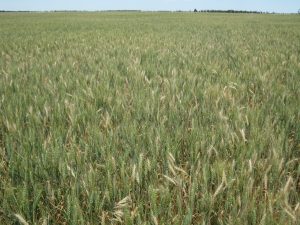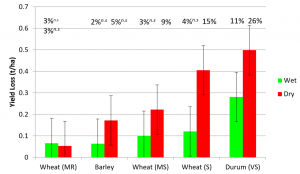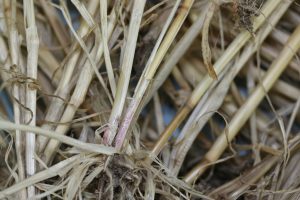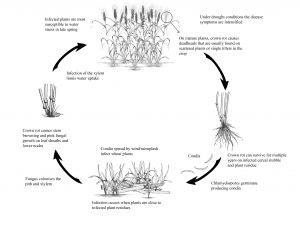Crown rot is an important disease in stubble retained cereal intensive cropping systems. Yield losses from crown rot are greater in season with a dry finish, compared to those with a wet spring. During seasons with below average rainfall crown rot causes whiteheads to develop in wheat crops resulting in yield losses of -5 to >20%. Yield losses in durum wheat are much greater than in bread wheat and can be more than 50 per cent.
The first step in controlling crown rot is to identify paddocks at risk. This can be done using a PREDICTA®B test before sowing, or through inspection of stem bases for symptoms of crown rot in a cereal crop. In paddocks with a high crown rot risk, rotation to non-cereals can reduce inoculum levels, while in paddocks with medium crown rot risk, avoiding durum and bread wheats can prevent large losses. There are a range of strategies that can contribute to reducing losses associated with crown rot
What to Look For
The symptoms of crown rot are most obvious on wheat plants close to maturity when they pre-maturely form white heads, also known as dead heads. The deadheads are either empty or partially filled with shrivelled grain. Affected plants may be scattered across a paddock or occur in patches. In addition to causing white heads, the fungus may also cause a seedling blight which can result in either pre- or post-emergent death. Plants affected by crown rot may be stunted and produce fewer tillers.

Crown rot causes deadheads that are usually found on scattered plants or single tillers in the crop.
Disease symptoms on the base of plants include honey brown discolouration of the crown, lower leaf sheaths and tillers.
Symptoms can extend up the stem where the fungus may form pink spore masses at the nodes. By comparison, plant roots and crowns affected by take-all are distinctly black in colour (See images in the take-all section).
Disease Cycle
The crown rot pathogen (Fusarium pseudograminearum and/or Fusarium culmorum) can survive for up to two years on infected cereal stubble from previous cereal plants, volunteer cereals or grass weeds. For this reason, stubble management is an important aspect in the control of crown rot. Survival is enhanced by dry summer conditions, but crop infection is favoured by moist humid conditions with temperatures between 15°C and 20°C.
Management
Crown rot management relies on:
- Identification of paddocks at risk.
- Strategies that reduce inoculum levels.
- Strategies that minimise losses in cereals.
There are no in-crop fungicide options for the control of crown rot.
Identification of paddocks at risk
The risk from crown rot in a paddock can be identified prior to planting, thus enabling losses from crown rot to be avoided. Either a PREDICTA® B test or inspection of stem bases for symptoms of crown rot in a previous cereal crop can be used to identify crown rot risk.
Reducing crown rot inoculum
Rotations
A grass free break from cereal decreases crown rot inoculum. The actual break crop used (e.g. oilseed, pasture, legume, fallow) does not make a large difference, so select a break crop most suited to the farming system.
Good rainfall increases the effectiveness of a break, as the cereal residues harbouring the pathogen are more readily decomposed by microbes during moist conditions.
For break crops, early canopy closure and warm, damp conditions under the canopy will result in the fastest decomposition of crown rot-infected plant residues and therefore reduced inoculum levels.
Where disease levels are high and there is low rainfall, it may take around 2-4 years for infected plant residues to decompose to reduce disease risk to a low enough level to sow durum wheat.
Managing stubble
Since crown rot is stubble borne, any strategies that accelerate the breakdown of stubble will also reduce the risk from crown rot. Within the plant the crown rot inoculum is more concentrated in the crown and the bottom seven centimetres of the stem.
Stubble management practices such as cultivating, spreading, slashing and grazing can increase the rate of stubble decomposition in the medium to long term. However, in the short term these practices can increase crown rot risk as they can increase the number of infected stubble pieces that can touch new crop plants and increase infection rates in the crop.
Fragments of stubble may be hard to see with the human eye, but even small fragments can carry the disease. PREDICTA® B testing is the most accurate way to determine these levels and avoiding planting cereals into paddocks at risk of loss from crown rot.
Reducing yield loss in cereals
If a cereal must be sown in a paddock with an identified risk to crown rot, there are strategies that can be adopted to minimise losses. Crop selection (i.e. avoiding cereal crops such as durum wheat which are prone to high yield loss) can reduce losses from crown rot and strategies such as inter-row sowing and time of sowing can also contribute to reducing losses.
Cereal type
As shown in Figure 6.16 cereal crops differ in their yield losses due to crown rot. Therefore, if a cereal is to be grown in a paddock with a crown rot risk, yield losses will be less if barley or oats are grown in preference to wheat or durum.
Note that even though barley has reduced yield loss from crown rot, it still increases inoculum levels which will increase the crown rot risk in that paddock. To reduce crown rot levels and avoid losses it is best to rotate to a non-cereal break. Barley most likely escapes yield loss due to its early maturity enabling it to finish before there is water stress at the end of the season.
Within wheat cultivars there is some variation in the extent of yield loss caused by crown rot and selecting more tolerant cultivars can reduce some yield loss. Also, GRDC is supporting pre-breeding research to develop wheat cultivars with improved resistance to crown rot to further improve the ability of future wheat cultivars to yield in the presence of crown rot.

Yield loss in cereals based on an analysis of 43 field experiments conducted in Victoria and South Australia in both wet (above average combined September and October rainfall) and dry seasons (below average combined September and October rainfall): 1998 to 2015.
Inter-row seeding
If cereals are to be planted into a paddock at risk of crown rot, the extent of the loss can be reduced by inter-row sowing. Since the majority of the crown rot inoculum is located in the stem bases of the previous cereal crop, planting in the inter-row increases the distance between the new crop and the old infected plants, thus decreasing the level of infection in the new crop.
Studies in the southern and northern regions have shown that planting in the inter-row can decrease the number of infected plants by about 50 per cent thus providing a small reduction in the extent of yield loss caused by crown rot.
Crop nutrition
As crown rot is more severe when a crop suffers from water stress late in the season, it is important to match nutritional inputs to expected yields and available stored water. Excessive early crop growth (bulky crops) can deplete stored soil water, increasing the risk of water stress during grain filling, particularly in seasons where water is more limiting.
Ensure crops have adequate zinc nutrition as whitehead expression can be more severe in zinc-deficient crops. Applying zinc above recommended rates will not provide further protection from crown rot.
Seed Applied Fungicides
There are no in-crop fungicide control options for crown rot. There are however, some seed treatments that may provide partial suppression of crown rot. These may be an advantage when used in conjunction with other management options.





